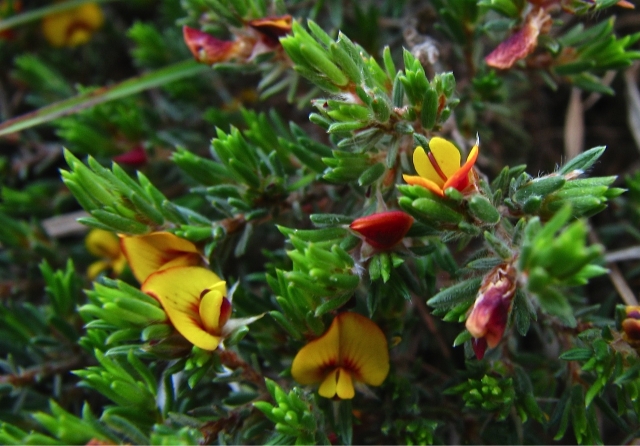Our glorious spring flowers…what a sight!
When walking along the cliff tops I have been surrounded by the wonderful fragrance of the copious tiny white flowers of Coastal Beard-heath Leucopogon parviflorus. They also gave me an exciting moment as I thought I had found an unknown species in flower under a bush. A closer look revealed it was numerous fallen Beard-heath flowers nestling in damp moss.

Moss Beard-heath
This month I again wish to highlight a few more of the species that have pea flowers. Large-leaf Bush-pea Pultenea daphnoides is looking quite dramatic in the heathlands and woodlands, as the large bushes are covered in bright yellow hooded flowers. The leaves are quite distinctive, being large and wedge-shaped, with a marked vein ending in a stiff point.

Large-leaf Bush-pea
I have enjoyed finding wonderful displays of two tiny, and less common peas along the cliff tops at Aireys Inlet. Common Eutaxia Eutaxia microphylla var microphylla is a low shrub with dense, stiff stems, tiny leaves and masses of delightful small yellow/orange flowers.

Common Eutaxia
Slender Bush-pea Pultenaea tenuifolia, a matted low-growing shrub has abundant, tiny, hooded yellow flowers with red markings The numbers of this plant seem to have increased markedly in recent years.

Slender Bush-pea
One of the brightest peas coming into flower in heathland and open forest is Dwarf Bush-pea Pultenaea humilis. I like the way its bright orange /red flowers contrast so beautifully with the fine soft, rich- green leaves which are also nice to feel…my sensory plant of the month.

Dwarf Bush-pea
I focussed on Parrot-peas Dillwynias last month. This month also be on the lookout for the latest to flower, the graceful Smooth Parrot-pea D. glaberrima. The flowers are always yellow and red, and grow near the end of the stems. Have a close look and you will see the stem’s leaves and calyx are hairless, and the slender leaves have a turned-out tip.

Smooth Parrot-pea
I wish to include one pea that is not yellow, and what better than Coast Swainson-pea Swainsona lessertifolia. You can’t miss its upright stems of eye-catching bright purple flowers in the sand dunes and nearby cliffs.

Coast Swainson-pea
Finally, a very different plant group with many species currently in flower: the graceful, low-growing Rice-flowers Pimelias. I have recently discovered that the coastal form, Thyme Rice-flower P. serpyllifolia subsp. serpyllifolia is dioecious, which means that it has male and female flowers on different plants. This had been flowering really abundantly along the cliff tops, and I have taken many photos of their tiny yellow clustered flowers and never noticed the difference! Have a look and see if you can spot it.

Thyme Rice-flower (female)

Thyme Rice-flower (male)
The propagation group has successfully grown them from cuttings for the first time also without realising this…so I wonder which sex will appear.
The other common Pimelias in our district all have much larger, white, distinctive terminal flower-heads comprised of a cluster of tiny four-petalled flowers. Mostly they seem to have female flowers in the centre of the cluster and male flowers around the edge, but I am still learning about them…watch this space!
The smallest is the Common P.humilis which is up to 25 cm in height, and the tallest is Slender P. linifolia subsp. linifolia, about 75 cm high.

Common Pimelia
Your Flowers of Anglesea and Aireys Inlet will be invaluable in helping identification of the multitude of plants in flower on your spring walks.
Ellinor Campbell